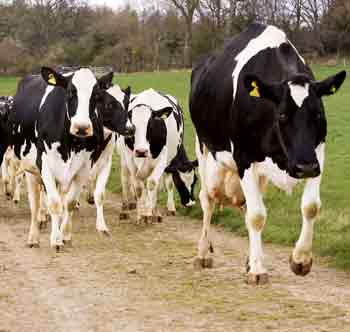Modern cows not to blame for poor fertility

Poor record keeping and lack of focused management are at the root of poor fertility not modern cows
High genetic dairy cows can get back in calf, despite the myth that today’s cows cannot get pregnant. It was perfectly possible for cows to give plenty of milk and get back in calf, said speakers at last week’s Fertility Counts Workshop, Reaseheath College.
The important thing is that farmers understood what they could do to make it happen, Neil Howie of Nantwich Vet Group told more than 80 delegates at the workshop funded by Elanco and the RDPE Northwest Livestock Programme.
“In biological terms, fertility is simply the ability to reproduce, but in management terms, it is the ability to reproduce efficiently at a rate to produce next year’s milk. The challenge in modern dairy herds is to manage when cows get in calf.”
Mr Howie said the focus had to be on knowing which cows were potentially due for service, then to spot cycling cows and get them served. “Many cows fail to get pregnant due to semen deficiency. They just don’t get served, so heat detection and a good understanding of the management factors that influence heat expression is still fundamental.”
 |
|---|
| Modern, high yielding Holstein cows aren’t necessarily more difficult to get in calf. But management of them to ensure pregnancy should centre around specific targets to provide measurable goals. |
“Mismanagement of fertility is still a major drain on profits and, as it is not something you write a cheque for, it is easy to underestimate the problems. This makes it even more important good records are kept and a plan followed.”
It took a deterioration in herd fertility to convince Carmarthenshire dairy farmer Howell Richards to take steps to clamp down on getting cows back in calf.
“In 2004 we had 335 cows averaging 7200 litres with a calving index of 400 days. By 2007 this had become 1000 cows averaging 6000 litres with a calving index of 440 days. The cost of extra replacements and lost production was more than £250 a cow.
“There were lots of reasons performance slipped. We were expanding, there was building work going on, we had a specific type of cow. But the truth is these are excuses not reasons.”
As a result, a set of specific objectives were set for the herd and a fertility program is used to produce detailed records and action lists.
“In addition to the farm staff our team now comprises the Genus RMS technician, our vet and a nutritionist. In this way we cover all the angles and take a rounded approach to fertility. The heart of the system is the action lists, which give us the detailed information we need.”
The vet now visits on Monday and Thursday. Thursday is PD day while Monday is fertility check day. All cows not served by 70 days are seen, as the target is to serve all cows by 100 days. Any cows found not in calf on Thursday are seen by the vet the following Monday.
Mr Richards told the conference that the target set by Genus RMS was for 20 pregnancies confirmed every week, and the vet visits soon highlighted any drift.
“Pregnant cows mean milk in the tank and we are now averaging 10,200 litres from 1200 cows with a calving interval of 378 days, which shows how a focused approach can have a significant impact.”
Independent vet consultant Kate Burnby from The Willows Vet Group stressed to the audience that target-setting was a vital part of getting to grips with fertility. “It is important to get an honest assessment of current performance and costs if a sensible programme is to be implemented.
“If you know where you are now and what fertility is costing, you can set realistic targets for improvements and a sensible budget for the investment to solve the problem.
“Improving fertility is all about getting cows to calve when you want them to as a means to maximising income. Therefore, improving fertility is an economic decision and it is important costs are in relation to potential gain. That said, many farms under-estimate what fertility really costs them,” she added.
